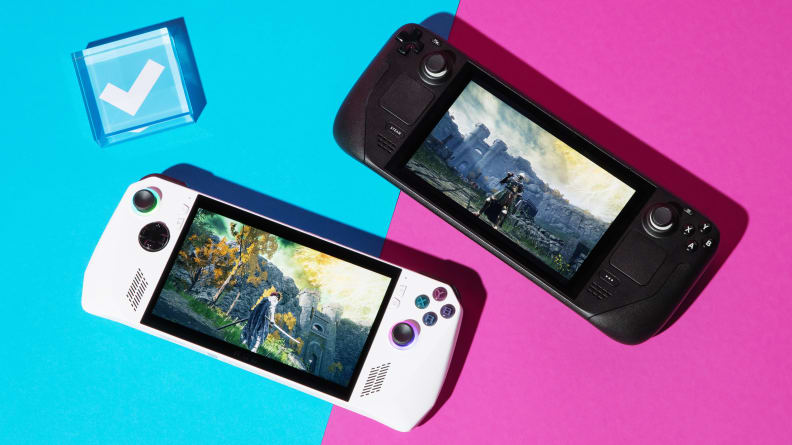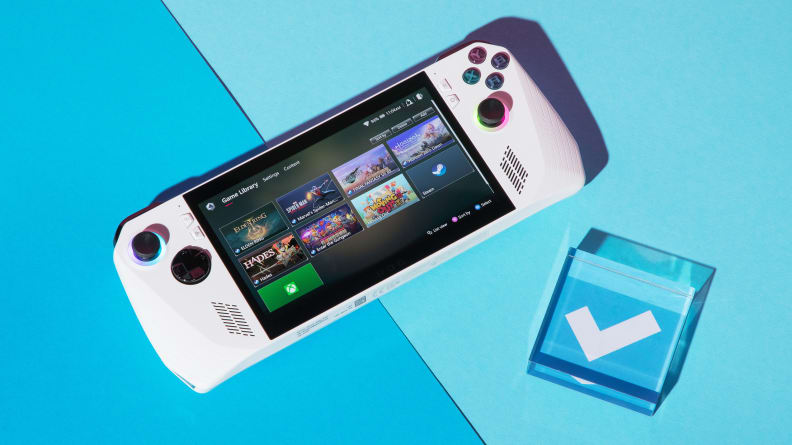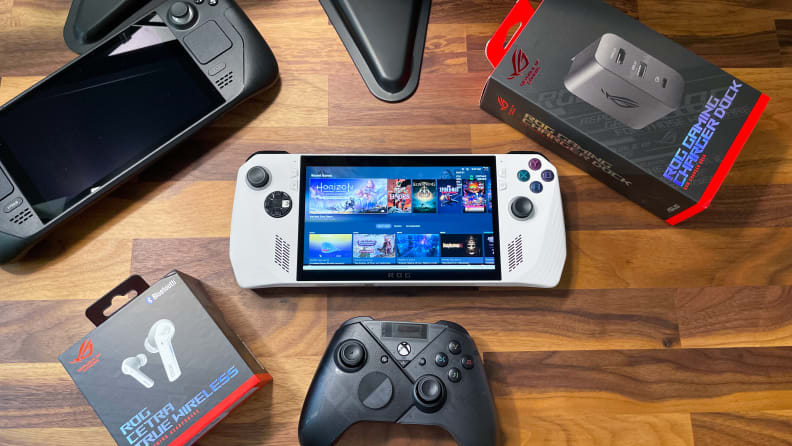Valve’s Steam Deck has dominated the handheld PC gaming scene since its launch, and the first major manufacturer has finally tossed its hat in the ring with the Asus ROG Ally.
It’s beautiful, powerful, and fairly priced, but is it enough to trounce the OG? The Ally’s strengths are perfect for games that need more power to run smoothly, but the Steam Deck is still a better value for those who want a pick-up-and-play experience that revolves around the Steam store.
Design and ergonomics
When you pick up the ROG Ally, you’ll notice it’s about an inch narrower and 0.3 pounds (608 grams) lighter than the Steam Deck. They’re both a similar shape (a 7-inch screen between a game controller), use similar inputs, and have plenty of customizability options.
The ROG Ally’s textured white finish and shallower grips can’t beat the ergonomics of the Steam Deck. Although the Ally is a third pound lighter and notably smaller, I found my hands cramping after an hour or two of use—on the Steam Deck, I’ve gone six hours or more before I begin to notice much discomfort. As a sufferer of small hands, I was surprised by the outcome.
The other major difference is the absence of trackpads on the ROG Ally. Many PC gamers have found the Steam Deck’s tiny mouse pads vital to strategy games and first-person shooters, where a mouse significantly improves the experience. Sure, they could be better, but at least they’re on the handheld. The ROG Ally does away with them, and instead the mouse is operated by the right joystick when in Desktop Mode.
The ROG Ally’s rear buttons are much more accessible and easy to trigger than the Steam Deck’s. The Ally has two extra rear buttons you can map to several desktop functions or keybinds (or create your own macro). When I hold the Steam Deck, I have to stretch my hand and press hard to activate the four rear buttons, so they’re not very useful in games where timing matters.
However, the Steam Deck also has better gamepad buttons overall. The D-pad, the ABXY buttons, joysticks, bumpers, and the triggers have a heftier feel to them that’s satisfying without being overbearing. It reminds me of an Xbox controller.
Our pick: Steam Deck
Performance
Even when the Steam Deck was new on the market, it wasn’t an especially fast device. A year and change later, it feels downright sluggish compared to the ROG Ally. Its custom AMD Ryzen processor runs on older architecture than the ROG Ally’s, which means it gets worse performance for the same power draw. At the Steam Deck’s native 800p resolution, exceptionally demanding games like Final Fantasy VII Remake and Elden Ring have a tough time running at 30 frames per second (fps) or more unless you drop the settings.
The ROG Ally runs on a 6-core, 12-thread AMD Ryzen Z1 Extreme processor, a tweaked version of the Ryzen 7840U mobile processor in architecture and performance. When we tested Elden Ring on the Ally for our review, the Ally was easily able to hold 30 fps at 1080p resolution and 60 fps at 720p resolution with high graphics presets.
If you’re bothered by fan noise, you’ll gravitate towards the ROG Ally. The Ally’s dual fan cooling system runs quieter and cooler than the Steam Deck’s single fan cooling system. Neither console is gratingly loud, but the Ally’s relatively silent operation is a godsend for low-volume audio usage.
Our pick: Asus ROG Ally
Battery Life and Power Usage
The Steam Deck’s greatest setback is also its secret weapon; the less powerful processor draws less power than the Ally’s. If a device demands more power, the device will also have a shorter battery life, and both handhelds pack a 40WHr battery.
The Steam Deck’s ultra low power draw is great for those who mostly play simple 2D games like Stardew Valley or visual novels, since you can get up to six hours of battery life using as little as 4 watts without missing out on performance.
When running at 15 watts, both the Steam Deck and the ROG Ally last about two hours off a full charge. Running games on the ROG Ally’s Silent mode will squeeze three hours of charge from the Ally’s battery. The ROG Ally’s maximum 30 watt power draw is the obvious choice for big budget, photorealistic 3D games that throw open worlds at players’ hardware like Horizon Zero Dawn, but you’ll be lucky to get a single hour’s worth of gameplay before running to a power outlet.
Our pick: Steam Deck
Price and Availability

Credit:
Reviewed / Timothy Renzi
The Steam Deck offers many different models that vary on your preferences and budget, but the Asus ROG Ally is not far out in price range from the best model offered by the former.
The Steam Deck starts at $399, which is a steal for all it offers. This model comes with 64GB of eMMC storage (an older, slower standard of flash storage), but it’s easy to upgrade yourself later on. The $529 model bumps storage up to a 256GB NVMe SSD, and the top-line $649 model comes with 512GB of storage and an anti-glare display. All models come with 16GB of 5500MHz DDR5 memory, a sturdy carrying case, and a charger.
Meanwhile, the ROG Ally is $700. However, that $50 goes far. Compared to the 512GB Steam Deck, the ROG Ally has the same amount of storage and RAM (although the memory is faster), a significantly better display and speakers, and a Windows 11 Home Edition license. The carrying case is sold separately.
You can only buy the Steam Deck on Valve’s online Steam store. There are some Steam Deck display models in limited Asian retail stores, but most people will have to wait for the console to arrive before they can give it a test run. The ROG Ally is a Best Buy exclusive, so you can try it before you buy in-store.
Our pick: Tie
Display

Credit:
Reviewed / Timothy Renzi
You will be able to run most modern games at high settings with the Asus ROG Ally.
In every single way, the ROG Ally’s screen demolishes the Steam Deck’s. The 1080p, 120Hz IPS display is bright, color accurate, and easy on the eyes. With up to 500 nits of brightness (enough to play in the bright sun) and coverage of 100% of the standard RGB color spectrum, everything looks phenomenal.
The Steam Deck’s display is best described as “fine.” The 800p, 60Hz IPS display isn’t notably blurrier than the Ally’s 1080p display thanks to the small screen dimensions on both devices, and the 60Hz refresh rate is enough to play games comfortably for most people. However, the Ally’s 120Hz screen feels so snappy and responsive that it’s hard to go back to the Deck.
While the Steam Deck is dimmer than the ROG Ally with a peak of 400 nits, those extra 100 nits only really make a difference in environments that tend to wash out your display. The Deck’s screen also has noticeably worse contrast and sRGB coverage that tops out at about 65%.
To me, the display is the Ally’s greatest improvement over the Steam Deck: it literally makes you a better gamer since you’re able to take in more information on-screen. Is this a touch dramatic? Sure. But I thank the 120Hz refresh rate and improved contrast for my better performance in Hades on the Ally compared to on the Steam Deck.
Our pick: Asus ROG Ally
Windows 11 vs SteamOS
In many ways, the operating system is the most divisive talking point of the Steam Deck vs ROG Ally faceoff. To some, Windows 11 is a blessing. To others (like me), it’s a curse. Windows and Steam’s custom Linux OS each have their pros and cons.
Out of the box, the Steam Deck does not run Windows. It runs SteamOS, a branch of Linux that Steam developed in-house for the Steam Deck. The base of the experience lies in Steam’s Big Picture Mode, which has been expanded and refined into a games-first menu to greet you when you turn it on. And that makes sense—put games at the center of a gaming device’s experience, just like PlayStation, Xbox, and Nintendo.
Accessing games from your Steam library on SteamOS is painless. You can scroll through games you own, browse Steam’s massive storefront, and organize non-Steam games in your library. If you need to get to some root files or want to try installing a custom mod, you can do that easily by switching SteamOS into Desktop Mode by clicking through the Power Menu.
Valve is cataloging its entire storefront to determine if each game is playable on the Steam Deck without any troubleshooting from a casual Steam Deck user. Verified games are guaranteed to work flawlessly with the Steam Deck’s layout.
Windows 11 is a lot more appealing for games not available on Steam. Most titles run without issue on SteamOS, but games with DRM, anti-cheat software like Denuvo, and games with independent launchers like EA Origin have been a sore spot for some.
That won’t be a problem when you’re running Windows on the ROG Ally. But I wouldn’t call this a strict pro for the ROG Ally—you can install Windows 11 to run on the Steam Deck, too. They’re both mobile computers at their core.
The problem with Windows 11 on the ROG Ally is the same problem Windows has with tablets and 2-in-1s: the OS was not designed with touch screens at the forefront of the user experience. Asus counteracted this with Armory Crate, software that acts as a hub similar to Steam’s Big Picture Mode for controlling the device and how it interacts with different games and services. It basically feels like a SteamOS imitator, but once you leave Armory Crate, you’re back to Windows 11.
Frankly, there is no clear winner between a handheld running SteamOS and a handheld running Windows. Windows 11 makes more sense for those that own a large library of games away from Steam or depend heavily on Xbox Game Pass and similar services. SteamOS is for people who want to stick to simplicity and unify their gaming with the Steam ecosystem.
Our pick: Tie
Accessories and repairability

Credit:
Reviewed / Timothy Renzi
There’s something to improve your experience with both handhelds.
I love the included Steam Deck case more than I thought I would. It’s sturdy, smooth, sleek, and convenient. I am a little miffed that the ROG Ally doesn’t come with a case, but in fairness neither does the Nintendo Switch, so I can’t dock it for that.
Both devices have great peripherals. The Steam Deck Dock and the ROG Ally’s Dock and 65-watt Charger hybrid both work well with their respective devices. Keyboards, mice, Bluetooth devices, and almost everything else you’d expect to work on a laptop or desktop work without issue. Both have slots for a microSD card, too.
If you find your Ally doesn’t have enough graphics power for your needs, you can connect it with an external laptop GPU and get desktop-grade performance. You can’t do that with the Steam Deck. The only issue with Asus’s eGPU enclosures is their cost, with the (mobile) RTX 4090 version costing $2,000.
For maintenance and repair, the Steam Deck and the ROG Ally are just as easy to take apart. Most hardware components like the storage and thumbsticks are modular. Replacing the SSD, fans, and other parts is simple enough. The Steam Deck currently has more custom parts available from first- and approved third-party manufacturers, but that could change in the future.
Our pick: Tie
And the winner is…
Despite how similar the Steam Deck and Asus ROG Ally seem, there is no clear winner between the two. Both consoles are great but the Steam Deck is up to $300 cheaper, making it the better choice for most gamers.
It’s powerful enough to run most modern big budget games at 800p, simple to navigate with its custom operating system, comfortable enough to hold for hours on end, and cheap enough to compete with the Nintendo Switch, PlayStation 5, and Xbox Series X|S for affordability.
However, Asus’s $700 ROG Ally is only $50 more expensive than the top-end Steam Deck, and offers major quality of life improvements like an 1080p display with twice the refresh rate and colors that pop off the screen, audio as good as a MacBook Pro, and significantly more power than the Steam Deck. It also comes with Windows 11 preinstalled, which could provide an extra layer of flexibility that gamers with libraries across the Epic Games Store, GOG, Origin, or Xbox Game Pass could take advantage of.
The ROG Ally and Steam Deck are not your only options for a PC gaming handheld, either. The Logitech G Cloud is great for cloud gamers, the Retroid Pocket 3 Plus provides the toolkit to run your favorite emulators, and the forthcoming Ayaneo 2S is a great alternative to the ROG Ally despite packing similar hardware.
The product experts at Reviewed have all your shopping needs covered. Follow Reviewed on Facebook, Twitter, Instagram, TikTok, or Flipboard for the latest deals, product reviews, and more.
Prices were accurate at the time this article was published but may change over time.










